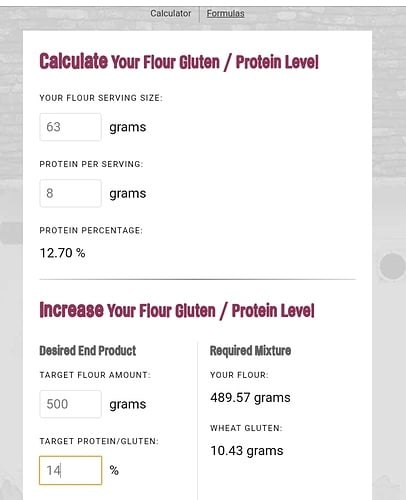Here goes. 
Let’s say that I need 500g high gluten flour at 14% protein content, but all I have on hand is bread flour that has 12.7% protein. I also happen to have some Vital Wheat Gluten that has 70% protein content. (Remember, gluten is a protein, but despite being called “Vital Wheat Gluten”, when you look at the Nutrition Facts info on its label, you will see that the Protein per Serving number is only about 70% of the Serving Size number so it is not actually “pure” protein or gluten.)
Now, enter the following numbers into my calculator:
500 in the Enriched Flour box.
14% into the Enriched Flour Protein box.
12.7% into the Flour Protein box.
70% into the Gluten Protein box.
The calculator will then say to use 489g of bread flour plus 11g of Vital Wheat Gluten, for a total of 500g of enriched flour at 14% protein.
Now we can check the answers. We already can see that 489g + 11g = 500g. That 500g of 14% protein flour should contain 500g * 14% = 70g of protein. The 489g of bread flour should contribute 489g * 12.7% = 62.1g of the protein. The 11g of Vital Wheat Gluten should contribute 11g * 70% = 7.7g of the protein. The combined protein is then 62.1g + 7.7g = 69.8g of protein. My calculator rounds to the nearest whole number, so 69.8g becomes 70g and that is the amount of protein we would expect from 500g of 14% protein flour.
Now, let’s compare this to the results from the Food Geek Vital Wheat Gluten Calculator.
Since we already know the % protein of our flour and Vital Wheat Gluten we would enter:
12.7 g per 100 g for Protein in your current flour.
70 g per 100 g for Protein in vital wheat gluten.
14 % for Target protein (percent).
500 g for Amount of flour needed (in grams).
Hit the Calculate button, and the calculator says to use 489g of your current flour with 11g of Vital Wheat Gluten, the same numbers you get from my calculator.
Note that the Food Geek calculator will calculate the % protein for your flour and for your Vital Wheat Gluten if you don’t already know those numbers. While you can usually find those numbers using a quick Internet search, you can just enter the Protein per Serving number and the Serving Size number for your flour and for the Vital Wheat Gluten and his calculator will do the rest. My calculator requires you to calculate the protein percentage yourself from those same 2 numbers if you don’t already know it. (% Protein = Protein per Serving / Serving size).
Note that the Protein per Serving numbers on nutrition labels are also rounded to the nearest whole number. For instance, my King Arthur Bread Flour label says the protein content is 4g per 30g serving which equals 13.3%, but right on the front of the package it says the Protein content is 12.7%. This is a consequence of them also rounding to the nearest whole number. With rounding, the actual protein content per serving could be anywhere between 3.5g and 4.5g, which could give a value anywhere between 11.7% and 15% protein. Some flour companies just commit to a range of values, but others like King Arthur commit to holding tighter tolerances on their protein content. Hopefully that can lead to more consistent results from bake to bake.
Make sense? All that being said, it is pretty difficult to get a precise answer for exactly how much gluten is in any given flour, but these calculators get you a ballpark figure that you can use as a starting point. Then after some trial bakes with possible adjustments of your % protein content up or down, you can use the calculator to hit your optimal protein level for all future bakes.
Hope this helps!

 Ultimately, it just gives you a starting point and the feel of the dough will help you decide if the hydration level is right.
Ultimately, it just gives you a starting point and the feel of the dough will help you decide if the hydration level is right.